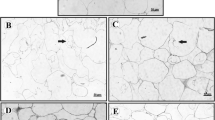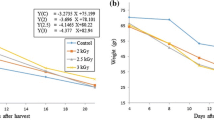Abstract
This study investigated the effect of pulsed light (PL) dose on color, microstructure, and microbiological stability of cut apples during 7-day refrigerated storage. Apples were irradiated at two different distances from the lamp (5 or 10 cm) during 2 to 100 s (2.4 to 221.1 J/cm2). Cut-apple surface exposed to high PL fluencies turned darker (lower L* values) and less green (higher a* value) than the control, and this effect was more pronounced as PL dose and/or storage time increased. On the contrary, the application of few flashes (2.4 J/cm2) allowed maintaining the original color of apples slices along storage. Light microscopy images of treated samples showed degraded walls and broken plasmalemma and tonoplast, which may explain, at least partially, the increase in browning of irradiated apples at high doses. Inactivation patterns of inoculated microorganisms depended on PL dose and the type of microorganism. After 100 s PL treatment at 5 cm, no counts were observed for Saccharomyces cerevisiae KE162, while for Escherichia coli ATCC 11229 and Listeria innocua ATCC 33090, reduction levels were 2.25 and 1.7 logs, respectively. Native microflora population was in general higher in control samples than in 10 and 60 s PL irradiated apples along the whole storage. Although the application of high PL fluencies allowed obtaining greater microbial reductions, they also promoted browning of apple. Application of PL at a dose of 11.9 J/cm2 could extend the shelf life of cut apple with minimal modification in color.




Similar content being viewed by others
References
Alzamora SM & Salvatori D (2006) Minimal Processing: Fundamental and Applications. In: Hiu (ed) Handbook of Food Science, Technology and Engineering, Vol. 3, pp. 118–1 – 118–6). CRC Press/Taylor & Francis, Boca Raton, USA.
Anderson JG, Rowan NJ., MacGregor SJ, Fouracre RA & Farish, O (2000) Inactivation of food-borne enteropathogenic bacteria and spoilage fungi using pulsed-light. IEEE Transactions on Plasma Science, 28, 83–88.
Bialka KL, Demirci A & Puri V (2008) Modeling the inactivation of Escherichia coli O157:H7 and Salmonella enterica on raspeberries and strawberries resulting from exposure to ozone or pulsed UV-light. Journal of Food Engineering, 85, 444–449.
Choi M-S, Cheigh C-I, Jeong, EA, Shin, JK & Chung M-S (2010) Nonthermal sterilization of Listeria monocytogenes in infant foods by intense pulsed-light treatment. Journal of Food Engineering, 97, 504–509.
Dunn JE., Clark RW, Asmus JF, Pearlman JS, Boyerr K & Painchaud F (1989) Methods for preservation of foodstuffs. US Patent No 4.871.559 (in USA).
Dunn J, Ott T. & Clark W (1995) Pulsed-light treatment of food and packing. Food Technology, 49, 95–98.
FDA (1996) Code of federal regulations. 21CFR179.41.
FDA (2000) Kinetics of microbial inactivation for alternative food processing technologies. Available at: http://www.cfsan.fda.gov/∼comm/ift-puls.html. Accesed 11 February 2009.
Gómez P, Alzamora SM, Castro MA, Salvatori DM (2010) Effect of ultraviolet-C light dose on quality of cut-apple: Microorganism, color and compression behavior. Journal of Food Engineering, 98, 60–70.
Gómez-López VM, Devlieghere F, Bonduelle V & Debevere J (2005a) Factors affecting the inactivation of micro-organisms by intense light pulses. Journal of Applied Microbiology, 99, 460–470.
Gómez-López VM, Devlieghere F, Bonduelle V & Debevere J (2005b) Intense light pulses decontamination of minimally processed vegetables and their shelf-life. International Journal of Food Microbiology, 103, 79–89.
Gómez-López VM, Ragaert P., Debevere J & Devlieghere F. (2007) Pulsed light for food decontamination: a review. Trends in Food Science & Technology, 18, 464–473.
Goupy P, Amiot MJ, Richard-Forget F, Duprat F, Aubert S & Nicolas J (1995) Enzymatic browning of model solutions and apple phenolic substrates by apple polyphenoloxidase. Journal of Food Science, 60, 497–501.
Jun S, Irudayaraj J, Demirci A & Gêiser D (2003) Pulsed UV-light treatment of corn meal for inactivation of Aspergillus niger spores. International Journal of Food Science and Technology, 38, 883–888.
Krishnamurthy K, Tewari JC, Irudayaraj J & Demirci A (2010) Microscopic and spectroscopic evaluation of inactivation of Staphylococcus aureus by pulsed UV light and infrared heating. Food and Bioprocess Technology, 3, 93–104.
Monsalve-González A, Barbosa-Cánovas GV, Cavalieri RP, McEvily A & Iyengar R (1993) Control of browning during storage of apple slices preserved by combined methods, 4-hexyl-resorcinol as antibrowning agent. Journal of Food Science, 58, 797–800
Oms-Oliu G & Martín-Belloso O (2010) Pulsed light treatments for food preservation. A review. Food and Bioprocess Technology, 3, 13–23.
Oms-Oliu G, Aguiló-Aguayo I, Martín-Belloso O & Soliva-Fortuny R (2010) Effects of pulsed light treatments on quality and antioxidant properties of fresh-cut mushrooms (Agaricus bisporus). Postharvest Biology and Technology, 56, 216–222.
Ozer NP & Demirci A (2006) Inactivation of Escherichia coli O157:H7 and Listeria monocytogenes inoculated on raw salmon fillets by pulsed UV-light treatment. International Journal of Food Science and Technology, 41, 354–360.
Pereira RN & Vicente AA (2010) Environmental impact of novel thermal and non-thermal technologies in food processing. Food Research International, 43, 1936–1943.
Rajkovic A, Smigic N & Devlieghere F (2010) Contemporary strategies in combating microbial contamination in food chain. International Journal of Food Microbiology, 141, S29-S42.
Sapers GM & Douglas FW (1987) Measurement of enzymatic browning at cut surfaces and in juice of raw apple and pear fruit. Journal of Food Science, 52, 1258–1262.
Sauer A & Moraru C (2009) Inactivation of Escherichia coli ATCC 25922 and Escherichia coli O157:H7 in apple juice and apple cider, using pulsed light treatment. Journal of Food Protection, 72, 937–944.
Sharma RR & Demirci A (2003) Inactivation of Escherichia coli O157:H7 on inoculated alfalfa seeds with pulsed ultraviolet light and response surface modeling. Journal of Food Science, 68, 1448–1453.
Takeshita K, Sibato J, Sameshima T, Fukunaga S, Isobe S, Arihara K & Itoh M. (2003) Damage of yeast cells induced by pulsed light irradiation. International Journal of Food Microbiology, 85, 151–158.
Uesugi AR, Woodling SE & Moraru CI (2007) Inactivation kinetics and factors of variability in the pulsed light treatment of Listeria innocua cells. Journal of Food Protection, 70, 2518–2525.
Woodling SE & Moraru CI (2005) Influence of surface topography on the effectiveness of pulsed light treatment for the inactivation of Listeria innocua on stainless-steel surfaces. Journal of Food Science, 70, M345-M351.
Woodling SE & Moraru CI (2007) Effect of spectral range in surface inactivation of Listeria innocua using broad-spectrum pulsed light. Journal of Food Protection, 70, 909–916.
Zar, JH (1999). Biostatistical analysis, 4th Edition, Prentice Hall, New Jersey.
Acknowledgments
The authors want to thank the financial support from Universidad de Buenos Aires, Universidad Nacional del Comahue, CONICET, and ANPCyT of Argentina and from BID. They also thank Dr. Francisco Manzano and Dra. Violeta D'Accurso for performing the fluence measurements.
Author information
Authors and Affiliations
Corresponding author
Rights and permissions
About this article
Cite this article
Gómez, P.L., Salvatori, D.M., García-Loredo, A. et al. Pulsed Light Treatment of Cut Apple: Dose Effect on Color, Structure, and Microbiological Stability. Food Bioprocess Technol 5, 2311–2322 (2012). https://doi.org/10.1007/s11947-011-0598-3
Received:
Accepted:
Published:
Issue Date:
DOI: https://doi.org/10.1007/s11947-011-0598-3




